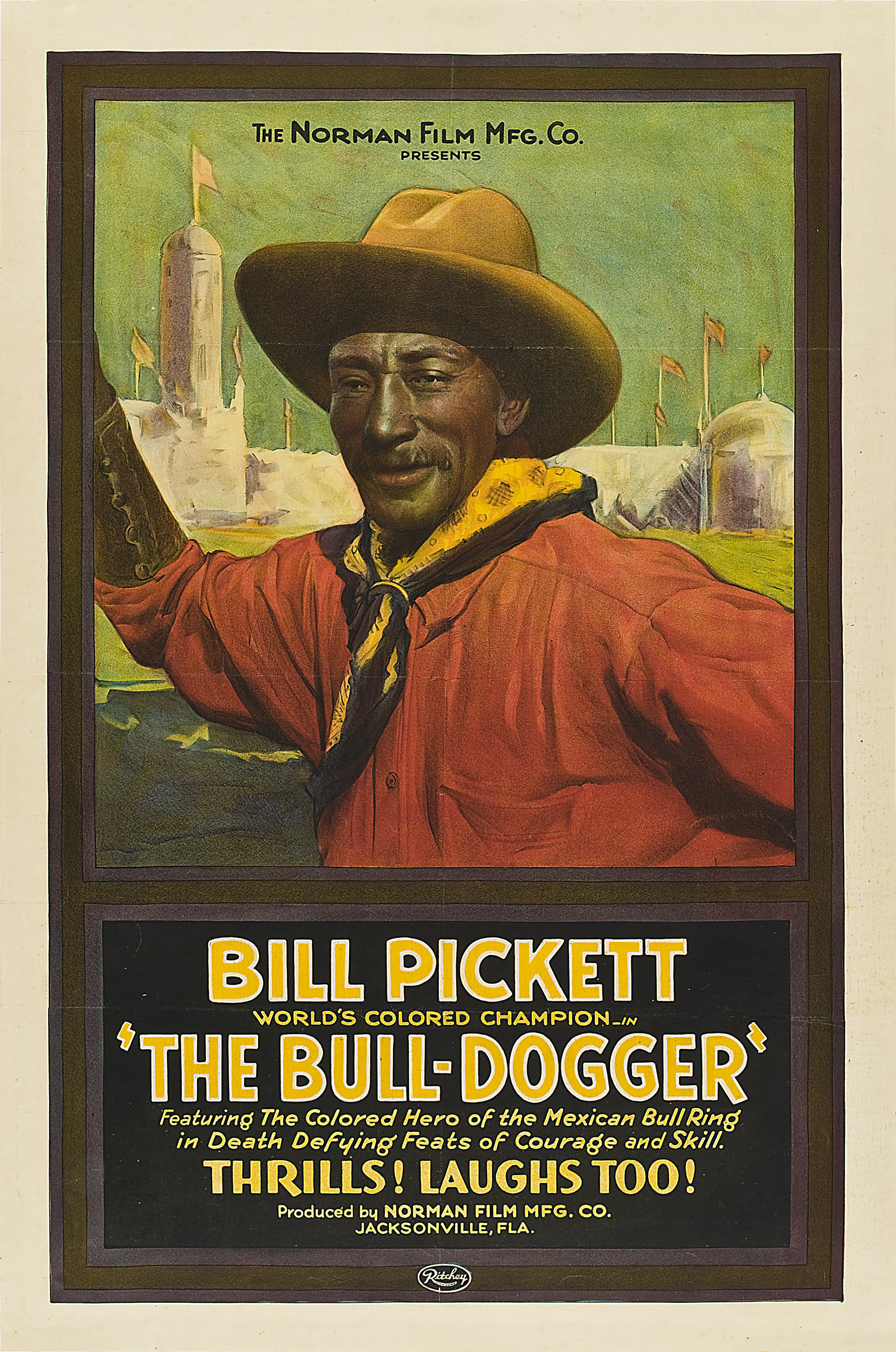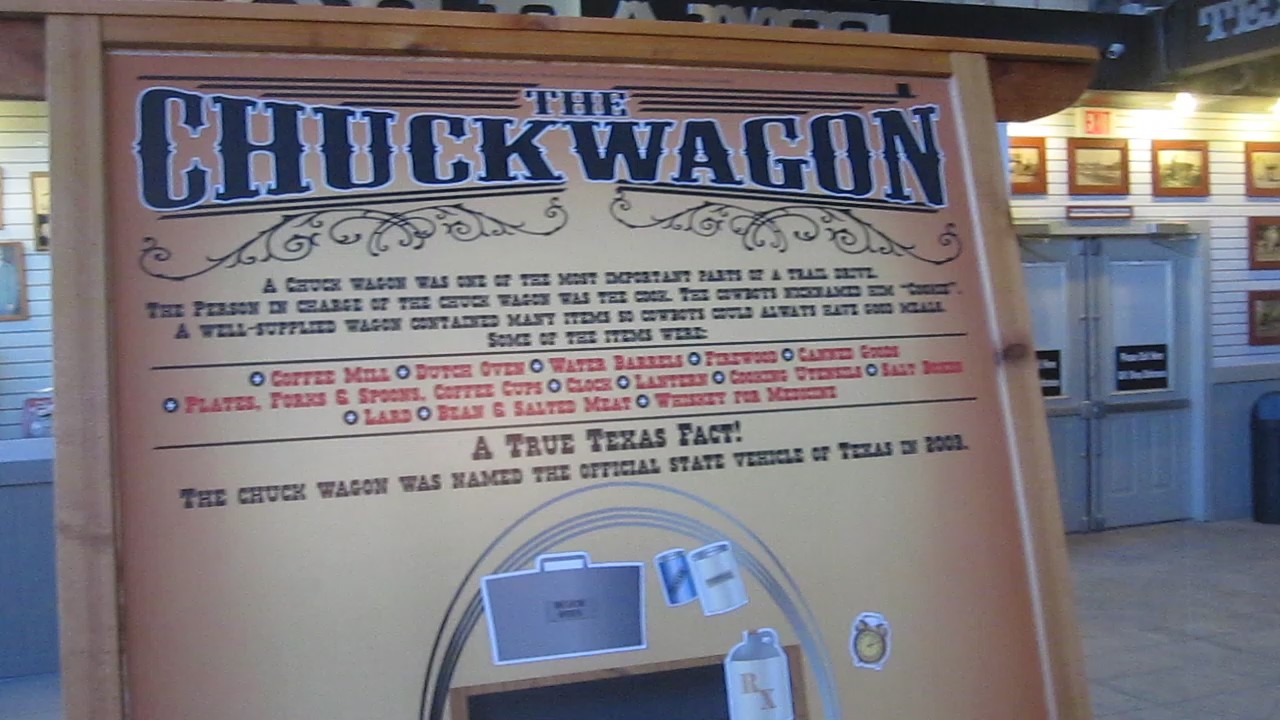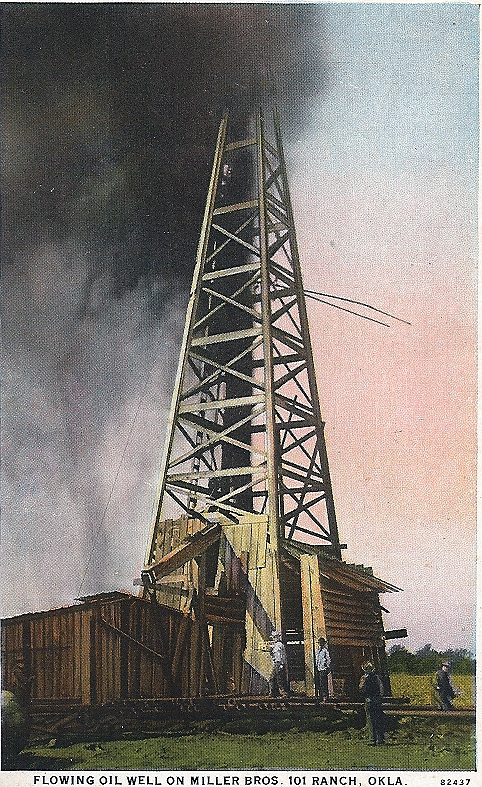|
Bulldogging
Steer wrestling, also known as bulldogging, is a rodeo event in which a horse-mounted rider chases a steer, drops from the horse to the steer, then wrestles the steer to the ground by grabbing its horns and pulling it off-balance so that it falls to the ground. The event carries a high risk of injury to the cowboy. Some concerns from the animal-rights community express that the competition may include practices that constitute cruelty to animals, but the injury rate to animals is less than 0.05%. A later PRCA survey of 60,971 animal performances at 198 rodeo performances and 73 sections of "slack" indicated 27 animals were injured, again around 0.05%. Origins Historically, steer wrestling was not a part of ranch life. The event originated in the 1890s, and is claimed to have been started by an individual named Bill Pickett, a wild-west show performer said to have caught a runaway steer by wrestling it to the ground. The several versions of the story have some claiming that he d ... [...More Info...] [...Related Items...] OR: [Wikipedia] [Google] [Baidu] |
Cowboy Morgan Evans
Charles "Cowboy" Morgan Evans (February 19, 1903 – April 15, 1969) was an American champion rodeo sports cowboy and oil field worker from Texas who worked as a rancher and oil drilling foreman the majority of his life. Evans won the 1927 World Series Rodeo Steer wrestling, Bulldogging Championship at New York City's Madison Square Garden (1925), Madison Square Garden. The World Series Rodeo is now known as the National Finals Rodeo (or "NFR"). Cowboy Evan's championship is recorded in the National Cowboy & Western Heritage Museum, Rodeo Hall of Fame at the National Cowboy & Western Heritage Museum in Oklahoma City, Oklahoma. Early life Charlie Morgan Evans was born to rancher Andrew Jackson Evans, Sr., and his wife Grace Morgan in the community of Huff, Texas in Archer County, Texas, Archer County. The family was of Scottish people, Scottish and Welsh people, Welsh descent. As an adult, in 1942, Evans legally changed his birth name from Charlie to Charles, but his rodeo name ... [...More Info...] [...Related Items...] OR: [Wikipedia] [Google] [Baidu] |
Equestrianism
Equestrianism (from Latin , , , 'horseman', 'horse'), commonly known as horse riding (Commonwealth English) or horseback riding (American English), includes the disciplines of riding, Driving (horse), driving, and Equestrian vaulting, vaulting. This broad description includes the use of horses for practical working animal, working purposes, transportation, recreational activities, artistic or cultural exercises, and animals in sport, competitive sport. Overview of equestrian activities Horses are horse training, trained and ridden for practical working purposes, such as in Mounted police, police work or for controlling herd animals on a ranch. They are also used in Horse#Sport, competitive sports including dressage, endurance riding, eventing, reining, show jumping, tent pegging, equestrian vaulting, vaulting, polo, horse racing, driving (horse), driving, and rodeo (see additional equestrian sports listed later in this article for more examples). Some popular forms of competi ... [...More Info...] [...Related Items...] OR: [Wikipedia] [Google] [Baidu] |
Wild West Show
Wild West shows were traveling vaudeville performances in the United States and Europe that existed around 1870–1920. The shows began as theatrical stage productions and evolved into open-air shows that depicted romanticized stereotypes of cowboys, Plains Indians, army scouts, outlaws, and wild animals that existed in the American West. While some of the storylines and characters were based on historical events, others were fictional or sensationalized. American Indians in particular were portrayed in a sensationalistic and exploitative manner. The shows introduced many western performers and personalities, and romanticized the American frontier, to a wide audience. History In the 19th century, following the American Civil War, stories and inexpensive dime novels depicting the American West and frontier life were becoming common. In 1869, author Ned Buntline wrote a novel about the buffalo hunter, U.S. Army scout, and guide William F. Buffalo Bill Cody called ''Buffal ... [...More Info...] [...Related Items...] OR: [Wikipedia] [Google] [Baidu] |
Bill Pickett
Willie M. Pickett (December 5, 1870 – April 2, 1932) was a cowboy, rodeo, Wild West show performer and actor. In 1989, Pickett was inducted into the ProRodeo Hall of Fame. Personal life Pickett was born in the Jenks Branch community of Williamson County, Texas in 1870. (Jenks Branch, also known as the Miller Community, is in western Williamson County, five miles southeast of Liberty Hill, and near the Travis County line.) He was the second of 13 children born to Thomas Jefferson Pickett, a former enslaved person, and Mary "Janie" Gilbert. Pickett had four brothers and eight sisters. The family's ancestry was African-American and Cherokee. By 1888, the family had moved to Taylor, Texas. In 1890, Pickett married Maggie Turner, the formerly enslaved daughter of a white southern plantation owner. The couple had nine children. Career Pickett left school in the 5th grade to become a ranch hand; he soon began to ride horses and watch the longhorn steers of his native Texas. ... [...More Info...] [...Related Items...] OR: [Wikipedia] [Google] [Baidu] |
National Cowboy & Western Heritage Museum
The National Cowboy & Western Heritage Museum is a museum in Oklahoma City, Oklahoma, United States, with more than 28,000 Western and American Indian art works and artifacts. The facility also has the world's most extensive collection of American rodeo photographs, barbed wire, saddlery, and early rodeo trophies. Museum collections focus on preserving and interpreting the heritage of the American West. The museum becomes an art gallery during the annual Prix de West Invitational Art Exhibition and Sale each June. The Prix de West Artists sell original works of art as a fund raiser for the museum. The expansion and renovation was designed by Curtis W. Fentress, FAIA, RIBA of Fentress Architects. History The museum was established in 1955 as the Cowboy Hall of Fame and Museum, from an idea proposed by Chester A. Reynolds, to honor the cowboy and his era. Later that same year, the name was changed to the National Cowboy Hall of Fame and Museum. In 1960, the name was changed ... [...More Info...] [...Related Items...] OR: [Wikipedia] [Google] [Baidu] |
Chuckwagon
A chuckwagon is a type of field kitchen covered wagon historically used for the storage and transportation of food and cooking equipment on the prairies of the United States and Canada. Such wagons formed part of a wagon train of settlers or fed traveling workers such as cowboys or loggers. In modern times, chuckwagons feature in certain cooking competitions and events. Chuckwagons are also used in a type of horse racing known as chuckwagon racing. History While some form of mobile kitchens had existed for generations, the invention of the chuckwagon is attributed to Charles Goodnight, a Texas rancher known as the "father of the Texas Panhandle," who introduced the concept in 1866.After the American Civil War, the beef market in Texas expanded. Some cattlemen herded cattle in parts of the country that did not have railroads, requiring them to be fed on the road for months at a time. Goodnight modified a Studebaker-manufactured covered wagon, a durable Civil War army-surpl ... [...More Info...] [...Related Items...] OR: [Wikipedia] [Google] [Baidu] |
Bullfighting
Bullfighting is a physical contest that involves a bullfighter attempting to subdue, immobilize, or kill a bull, usually according to a set of rules, guidelines, or cultural expectations. There are several variations, including some forms which involve dancing around or leaping over a cow or bull or attempting to grasp an object tied to the animal's horns. The best-known form of bullfighting is Spanish-style bullfighting, practiced in Spain, Portugal, Southern France, Mexico, Colombia, Ecuador, Venezuela, and Peru. The Spanish Fighting Bull is bred for its aggression and physique, and is raised free-range with little human contact. The practice of bullfighting is controversial because of a range of concerns including animal welfare, funding, and religion. While some forms are considered a blood sport, in some countries, for example Spain, it is defined as an art form or cultural event, and local regulations define it as a cultural event or heritage. Bullfighting is ill ... [...More Info...] [...Related Items...] OR: [Wikipedia] [Google] [Baidu] |
Steer Wrestlers
Steer, Steers or Steering may refer to: Animals * Steer or bullock, castrated male cattle * Ox, a steer used as a draft animal People * Steer (surname) * Steers (surname) Places * Steer Creek (West Virginia), a tributary of the Little Kanawha River in central West Virginia in the United States * Steer Island, a former bar island in Summers County, West Virginia * Steer Stadium, a baseball park located in Graham, Texas Other uses * Steering, mechanism used to turn a vehicle * "Steer" (song), a 2007 song by Missy Higgins * Steers, South African fast food chain * STEER, a variant of PEST Pest or The Pest may refer to: Science and medicine * Pest (organism), an animal or plant deemed to be detrimental to humans or human concerns ** Weed, a plant considered undesirable * Infectious disease, an illness resulting from an infection ** ..., a technique used in business analysis See also * Steers (other) * Steerage (other) {{disambiguation ... [...More Info...] [...Related Items...] OR: [Wikipedia] [Google] [Baidu] |
Rodeo
Rodeo () is a competitive equestrian sport that arose out of the working practices of cattle herding in Spain and Mexico, expanding throughout the Americas and to other nations. It was originally based on the skills required of the working vaqueros and later, cowboys, in what today is the western United States, western Canada, and northern Mexico. Today, it is a sporting event that involves horses and other livestock, designed to test the skill and speed of the cowboys and cowgirls. American-style professional rodeos generally comprise the following events: tie-down roping, team roping, steer wrestling, saddle bronc riding, bareback bronc riding, bull riding and barrel racing. The events are divided into two basic categories: the rough stock events and the timed events. Depending on sanctioning organization and region, other events such as breakaway roping, goat tying, and pole bending may also be a part of some rodeos. The "world's first public cowboy contest" w ... [...More Info...] [...Related Items...] OR: [Wikipedia] [Google] [Baidu] |
Chute Dogging
Chute dogging is a rodeo event related to steer wrestling, in which the steer used weighs between . However, the competitor starts the event in a roping chute with the steer as opposed to grabbing onto the steer from horseback. The event is designed to give novices a chance to prepare for steer wrestling. When the chute opens, the competitor must bring the steer to a line ten feet from the chute and wrestle (or "dog") the steer to the ground. In order to count as a legal fall, all four feet of the steer must be in the air when the steer is on the ground. Other falls are called "dog falls," and the competitor must try to let the steer get up and try to get all four legs in the air. The competitor can be disqualified for losing contact with the steer or tripping the steer. It is a timed event, with the time starting at the moment the chute dogger crosses the ten-foot line. The steer must be wrestled within 60 seconds. ReferencesSanctioned eventsat the International Gay Rodeo Assoc ... [...More Info...] [...Related Items...] OR: [Wikipedia] [Google] [Baidu] |
101 Ranch Wild West Show
The Miller Brothers 101 Ranch was a cattle ranch in the Indian Territory of Oklahoma before statehood. Located near modern-day Ponca City, it was founded by Colonel George Washington Miller, a veteran of the Confederate Army, in 1893.Hoy, JimCattle Industry" Encyclopedia of Oklahoma History and Culture' (accessed March 5, 2015). The 101 Ranch was the birthplace of the 101 Ranch Wild West Show and one of the early focal points of the oil rush in northeastern Oklahoma. It was the largest diversified farm and ranch in America at the time. Bill Pickett's grave and the White Eagle Monument are located on the ranch grounds. The location of the former working cattle ranch was subdivided and all of its buildings destroyed. An area of the ranch is a National Historic Landmark. In 2003, the ranch was inducted into the Texas Trail of Fame. In 1903, when Colonel George Miller died, his three sons, Joseph, George Jr., and Zack took over operation of the 110,000 acre ranch. By 1932 most ... [...More Info...] [...Related Items...] OR: [Wikipedia] [Google] [Baidu] |





.jpg)
